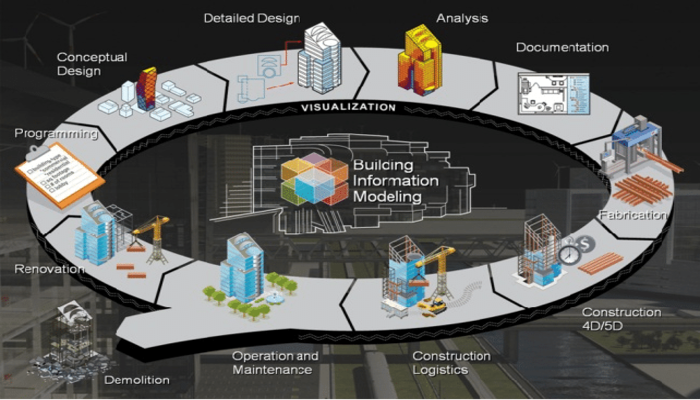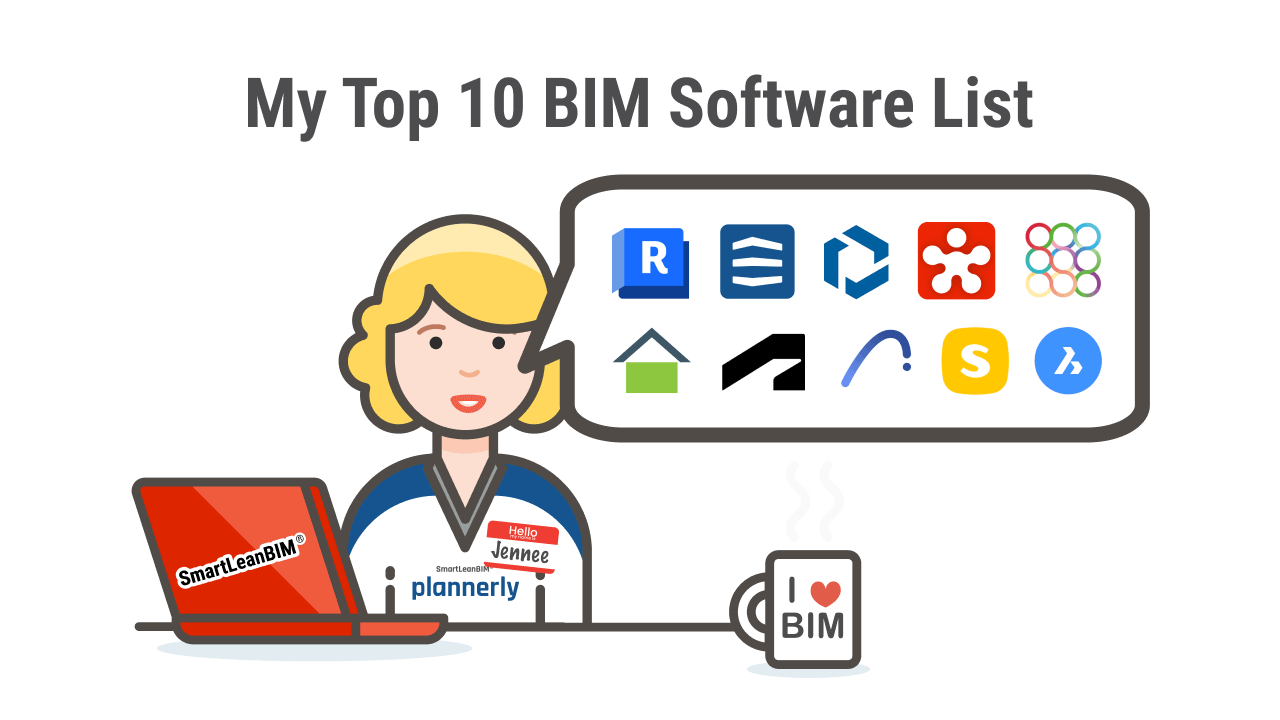
We know how Building Information Modelling (BIM) streamlines processes and improves collaboration amongst stakeholders. But there’s more to it. BIM process involves creating, sustaining, and utilising building data during the entire construction project lifecycle. Let’s now understand the application of BIM processes in different phases of construction - design, construction, and operation and maintenance via information.
BIM for Construction Project Lifecycle
Building Information Modelling, or BIM, is a futuristic methodology that has resolved perpetual clashes and reconciled differences, as they say in Architecture, Engineering and Construction (AEC) “folklore". Never-ending discussions, infinite feedback, miscommunications, design errors, and revisions have come to an end. Well, the adaptation of technology makes it easier, doesn’t it?
BIM is a technology that creates a highly collaborative platform for intelligent management and the generation of a building’s data that is recorded during the construction project lifecycle. This data includes the environment, geometry, geography, costs, materials, spatial analysis, and more. This methodology makes designing, planning, construction, and management more efficient. Revolutionising the AEC industry by digitally transforming construction processes, BIM for the construction project lifecycle is a centripetal concept that is driving the impending chapter of sustainability.
How does BIM Project Lifecycle Work?
Building Information Modelling is employed to incorporate coherent insights into real-life structures. But is BIM different from Computer-Aided Design (CAD)? The answer is yes. While AutoCAD assists in drafting and designing, BIM makes designing smarter, more dynamic, and more visual by using CAD as a tool, producing information that can later be integrated into built forms.
The ‘I’ in BIM represents ‘information-driven decision-making'. With smart buildings taking over the scope of infrastructure, facility managers are keeping themselves busy charting out smarter ways of handling construction processes. Times like these call for digitisation of building life cycles. And that’s where BIM in a project lifecycle becomes the rescuer!
Also Read: How BIM was Used to Ease the Construction of Abu Dhabi International Airport?
Benefits of BIM for a Construction Project Lifecycle?
The concept of BIM for construction project lifecycle is the process of generating, maintaining, and utilising building information. But how does this justify the influence of BIM in the AEC industry?
1. Benefits of BIM for Information Management

- Information about all building components is useful throughout the building lifecycle, from the design stage to maintenance.
- BIM helps create a 3D model that becomes a central location for stakeholders to add or extract information.
- BIM is employed in scheduling via 4D models during the phases of construction, modification, and maintenance.
- BIM also assists in creating 5D models that help reduce expenses and maintenance costs.
- BIM allows creating 6D models that help answer different aspects of a building’s life cycle, such as the ‘what, when, who, and how’.
2. Benefits of BIM for Facility Management

- Better Spatial Analysis: BIM assists in spatial analysis, which in turn reduces negative spaces. This ultimately leads to a maintenance cost reduction.
- Efficient Maintenance: Managing and maintaining information gets tricky when it comes to big-scale projects. This is where BIM steps in and assists in streamlining information maintenance, eliminating the extra workforce.
- Efficient Energy Consumption: Facility managers use BIM to implement eco-friendly practices by charting out energy alternatives to the inefficient ones. This, in turn, enhances the building's performance.
- In-budget Renovations: BIM services contribute to delivering accurate data on the existing project state. This reduces time and money spent on renovation and streamlines processes.
- Lifecycle Management: BIM assists in providing an elaborate understanding of materials with lower maintenance costs. This ultimately helps reduce the overall lifecycle cost.
Also Read: Top 7 Places to learn BIM for Civil Engineers (2025)
Applications of BIM in facility management

You might be under the impression that BIM is only a part of the project lifecycle during the initial stages. But BIM allows leveraging data for a prolonged period , utilising the Total Cost of Ownership (TCO) that is spent on maintenance and operations.
BIM for construction project lifecycle helps us understand some prime aspects of a built form, including:
- The service record for ‘X’ this year
- The effect of an upgrade ‘Y’ on holistic systems
- Asset cost for essential facility maintenance framework.
BIM assists in analysing the costs of a real-time structure that is modelled with facilities and resolves data when needed. It’s different, right? To understand the costs when you see them as materials in built form and to put them down on a balance sheet. But in the end, it all comes down to cost savings. And that’s why facility managers have turned to BIM.
In a construction project lifecycle, BIM helps with insights into crucial systems and allows the user to model the effects that are associated with repairs, maintenance, or any improvements. This leads to data-backed solutions through a record system that integrates with space management software.
With the wave of digitisation swaying almost every industry with it, the construction industry is not behind. From digital models to the Internet of Things (IoT), all of it works on interlinked contextual data points that are implemented in the ecosystem of a building. Example: BIM creates digital twins of physical structures based on energy usage and temperature. With each data point adding to the much greater BIM schema, facility managers also get an ocean of information to work with, hence creating the best management approaches.
Applications of BIM in Information Management in a Construction Project Lifecycle
Life-cycle management (LCM) is a business approach that helps with managing the total life-cycle of services and products. This methodology helps reduce time, cost, and risk and improves services. There is ample building information that is stored and repurposed, which further enhances communication. With enhanced management of construction information, the stakeholders can collaborate well, leading to successful project execution. This ultimately irons out the creases in information sharing that are usually scattered due to a lack of efficient information-sharing platforms.
Breaking down information management in a project lifecycle, let’s further discuss the components, flow of information, and function of information.
1. Information Components Throughout a Construction Project Lifecycle
The information about a building's life cycle is represented in varying formats, and BIM is the digital tool that represents all the data. This, in turn, helps us manage and store information according to its phases.
Let’s briefly discuss the information components in each phase:
A. Information components in the design phase of a construction project lifecycle
The design phase involves demonstrating the client’s construction plans, encompassing the proposed functional needs and project standards, via a digital model.
Information framework for the design phase:
- Public information about the project
- Information related to similar projects
- Location information about the proposed project
- Survey and design information
- Building and contract information
- Economic information
B. Information components in the construction phase of a construction project lifecycle
Controlling and managing construction is a dynamic process, which ultimately broadens the scope of C-BIM. This is a prolonged and complicated process that involves general contractors, subcontractors, owners, equipment and material suppliers, and relevant government departments. Apart from this, it’s essential to keep human and material resources prepared for utilisation during the construction phase.
Information framework for the construction phase in a project lifecycle:
- Project public information
- General situation information
- Technology information
- Construction management information
- Resource information
- Environmental information
- Information related to similar projects
C. Information components in the operation phase of a construction project lifecycle
Operation management provides users with a comfortable environment, ensuring the performance of building facilities and achieving sustainable applications.
Information framework for the operation phase:
- Public information
- Takeover information
- Contract documents and record information
- Project situations
- User information
- Environmental information
- Building information
- Equipment information
- Economic information
- Public security and disaster protection information
2. Information Flow Throughout a Construction Project Lifecycle

Information related to numerous departments and components, from design to the operation phase, keeps circulating and updating on BIM platforms. This streamlines information exchange and collaboration.
A. Information Flow in the Design Process:
The design process is divided into three departments: structural design, facility engineering design, and architectural design. Facility engineering design encapsulates electrical design, drainage design, water supply design, Heating, Ventilation, and Air Conditioning (HVAC) design, and thermal power system design.
B. Information Flow in Construction Process:
The architectural and structural engineering phases have been divided into four categories: main structure engineering, foundation engineering, waterproof engineering, and building decoration engineering. Here’s the information flow in the construction and structural engineering stages:
C. Information Flow in Operation Process:
The operation phase includes property use, maintenance, reception, and demolition. This stage involves transferring property rights from a construction firm to a property management firm.
3. BIM Application Throughout the Project Lifecycle

Construction projects make use of BIM across different stages, with cost benefits included, but the potential value of BIM for construction project lifecycle management is often underused. BIM primarily helps with accurate multi-disciplinary modelling and improved information tasks like retrieval, creation, communication, and delivery. Efficiency in material handling through BIM’s integration comes as a secondary effect. BIM for construction project lifecycle serves as a reliable knowledge resource for making informed decisions throughout its entire lifecycle. It’s like a digital facility of data.
The process of construction isn’t just about designing and building structures; it’s more than that. From blueprints being on paper to getting built on site with extensive labour, construction processes are longer and more complicated than one might perceive. But here, BIM becomes our hero and helps in optimising different stages of the construction process, making it more efficient and accessible. From streamlining design to managing expensive and dangerous equipment to working on massive sites and collaborating with contractors, implementing BIM enhances different phases of the construction process.
Also learn how: Top In-Demand Civil Engineering Specialisations in 2024
A. Planning and Design
Architects love being creative, right? While designing and planning are substantial processes individually, they are seen as integral parts of the construction process. With BIM in the picture, we can optimise them, make them more efficient, and also avoid technical clashes. BIM factors in data to optimise design and performance analytics to create simulated prototype models. With BIM involved in a construction project lifecycle, one can easily detect potential clashes during this stage, hence saving time, cost, and resources.
B. Construction
Think of BIM as a white flag between multiple stakeholders involved in a project that smooths communication and makes working together much easier. BIM offers smart tools that allow real-time monitoring of the on-site construction work, along with coordination with suppliers. Making construction processes more visual, BIM helps in developing and walking them through the construction phases.
C. Operations and Maintenance
One of the last legs of construction is maintaining and operating these structures, and here’s where BIM comes handy in streamlining post-construction processes. Adding value to collaboration and maintenance, BIM helps clients and facility managers operate Heating, Ventilation, and Air Conditioning (HVAC), Mechanical, Electrical, and Plumbing (MEP), and deal with clashes through a digital twin that helps us assess materials, lifespan, installation date, etc.
Effects of BIM on different construction phases
Construction projects walk through three major phases during their lifecycle:
Design [D], Construction [C], and Operations [O]. These phases are then further subdivided into sub-activities, tasks, and activities. This conceptual model showcases the effects of BIM for construction project lifecycle over the BIM stages.
BIM in Management of a Construction Project Lifecycle 
The applications of BIM not only help optimise different phases in a construction project’s lifecycle but also assist with lifecycle management. As discussed above, these benefits include risk management, collaboration, and sustainability analysis for efficient workflows.
| Application | Function | Requirement |
| Collaboration | A platform for negotiating between different software and stakeholders | End-to-end information of different phases, creating a regulatory standard. |
| Reduce Risks | Check for adverse events and focus on productivity in a construction process | Data from alike projects and critical data from the ongoing project |
| Sustainabiliy analysis | Focus on the building’s sustainability factor, by analysing the complex building performance | Information of different phases needed to analyse cost along with other information for life-cycle assessment |
Conclusion
The increasing demand for tech-integrated projects and processes has skyrocketed the adaptation of technologies. Enabling BIM not only streamlines processes but also helps channel information and utilise it in analysis and visualisation. BIM models provide a virtual repository of data that acts as a resource for optimising building performance, management, and construction. This ultimately acts as a skeleton for the BIM-based construction project lifecycle.
And if BIM processes hit a chord with you, why don't you learn more about it as well? Here’s something that might interest you Novatroffers a BIM Professional Course for Civil Engineers that will help you understand industry workflows and advanced tools for streamlined construction processes. Learn high-performance computational BIM and building analysis via a live industry project. Bag opportunities along with professional certification, endless career possibilities, and upskilling.
Was this content helpful to you




-1.png)


.png)